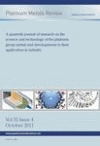-
oa The Use of Platinum by Carl Fabergé
New Evidence from the Design Books of Holmström
- Source: Platinum Metals Review, Volume 37, Issue 3, Jul 1993, p. 159 - 164
-
- 01 Jan 1993
Abstract
Combining imaginative design with outstanding craftsmanship, the decorative objects made by Fabergé for many years Goldsmith to the Imperial Court of Russia, were intended not only to delight but also, in many instances, to amuse those fortunate enough to receive them. The masterpieces produced in his workshops continue to be highly regarded by museums and private collectors, and demonstrate his ability to use a wide variety of precious materials, including platinum and its alloys, to create fascinating objects for a privileged clientele, which was later destroyed or dispersed by the combined effects of the First World War and the Russian Revolution.
© Johnson Matthey


